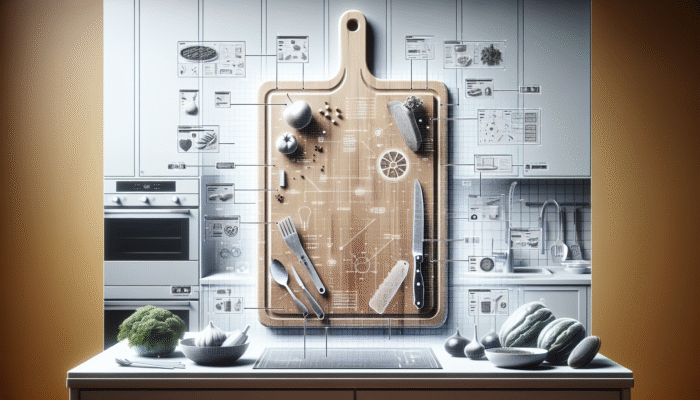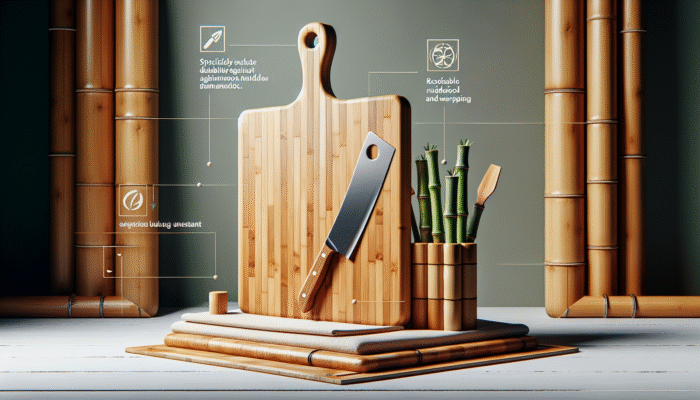Explore Sustainable Materials for Eco-Friendly Cutting Boards in Your Kitchen
Cutting boards are essential tools in every kitchen, and with the increasing focus on sustainability, understanding how to select an eco-friendly cutting board has become more important than ever. The materials used in these kitchen essentials significantly impact their environmental footprint. In this comprehensive guide, we will delve into the most prevalent materials used for cutting boards, including wood, bamboo, and plastic. We will examine how each option aligns with sustainable practices and contributes to eco-friendly living.
Choose the Most Eco-Conscious Wooden Cutting Board for Your Kitchen Needs

Wooden cutting boards have remained a staple in kitchens around the world thanks to their durability and visual appeal. However, it is crucial to recognise that not all wood is equally sustainable. Certain types are sourced from responsibly managed forests, while others may contribute to destructive practices such as deforestation and loss of natural habitats. When selecting a wooden cutting board, prioritise options made from hardwoods like maple, walnut, or cherry. These hardwoods not only resist knife marks effectively but also develop a distinctive character over time, enhancing their aesthetic value.
The sustainability of wood sourcing is heavily influenced by responsible logging practices. The Forest Stewardship Council (FSC) certification plays a vital role, assuring consumers that wood products originate from forests managed in a manner that conserves the ecosystem. By opting for an FSC-certified wooden cutting board, you advocate for environmentally sound practices while supporting global efforts toward forest conservation. Moreover, wooden boards boast natural antibacterial properties, making them a healthier choice for food preparation compared to synthetic materials, thus ensuring safer culinary experiences.
It is also important to take into account the growth rates of the trees used for these boards. Fast-growing tree species can replenish much quicker, thus rendering them more sustainable options. Whenever possible, select locally sourced wood instead of imported varieties; this choice not only lowers transportation emissions but also supports local economies and communities, contributing to a more sustainable future.
Uncover the Eco-Friendly Benefits of Bamboo Cutting Boards
In recent years, bamboo has gained significant popularity as a sustainable alternative to traditional wooden cutting boards. This extraordinary grass can grow as much as 91 centimetres in a single day, making it one of the fastest-growing plants on the planet. Its rapid growth and low water requirements render bamboo an eco-friendly option for those aiming to reduce their environmental footprint during food preparation.
When choosing a bamboo cutting board, ensure it is made from 100% organic bamboo and is free from harmful chemicals or additives. Some bamboo boards may be treated with formaldehyde during manufacturing, which can leach into food and pose health risks. Opt for brands dedicated to eco-friendly practices and those that use natural adhesives in their production processes, ensuring a safer product for your kitchen.
Bamboo cutting boards are not only durable and resistant to knife marks, but they also exhibit natural antimicrobial properties, facilitating hygienic food preparation. Additionally, bamboo boards are typically lighter than their wooden counterparts, resulting in reduced energy consumption during transportation. As a further advantage, bamboo cutting boards often feature unique and attractive grain patterns, adding visual interest to your kitchen.
As consumers become increasingly aware of their environmental impact, bamboo cutting boards stand out as an excellent choice for those seeking to embrace a sustainable lifestyle without compromising on quality or aesthetics.
Assessing the Environmental Consequences of Plastic Cutting Boards
Plastic cutting boards are commonly found in many kitchens due to their affordability and practicality. However, when considering how to choose a sustainable cutting board, it is essential to evaluate the environmental implications associated with plastic. While some plastics can be made from recycled materials, they often contribute to the alarming issue of microplastics infiltrating our food systems and waterways, posing serious risks to both human health and the environment.
When selecting a plastic cutting board, seek out products made from recycled plastics or those marked as BPA-free, since bisphenol A can leach into food and pose significant health hazards. Although plastic boards are lightweight and dishwasher safe, they generally lack the durability found in wooden or bamboo options. The need to frequently replace plastic boards due to wear and tear can lead to increased waste and environmental degradation.
Moreover, it is crucial to assess the full lifecycle of plastic. While plastic boards may initially seem to create less waste, improper disposal can lead to pollution and long-lasting environmental damage. Always consult local recycling guidelines to ensure the responsible disposal of plastic cutting boards and minimise your environmental footprint.
In recent years, innovative sustainable plastics have begun to emerge. Some brands now offer biodegradable alternatives that decompose over time, thereby reducing landfill waste. These advancements reflect a shift towards more sustainable manufacturing practices in the plastic industry and underscore the importance of consumer awareness in driving positive change.
Examine the Longevity of Your Cutting Board Choices

Durability is a crucial aspect when determining how to choose a sustainable cutting board. The lifespan of a cutting board directly correlates with its environmental impact. Boards that endure longer require fewer replacements, thus minimising waste and resource consumption, ultimately benefitting the planet.
Comprehending the Lifespan of Your Cutting Boards
Investing in a durable cutting board is a wise decision for any environmentally conscious consumer. A well-constructed board can last for years, even decades, while cheaper alternatives tend to deteriorate rapidly, leading to more frequent purchases and greater waste generation. High-quality wooden and bamboo boards, when properly cared for, typically outlast their plastic counterparts significantly.
Beyond longevity, consider the emotional attachment you may develop with your cutting board. A beautifully crafted wooden board can become a cherished tool in your kitchen, carrying memories of meals prepared and shared over time. The longer a cutting board lasts, the more value it provides, reinforcing its position as a sustainable choice.
Moreover, durability translates into financial savings. Although the initial cost of a high-quality cutting board may be higher, its prolonged lifespan can result in significant savings over time. Remember, choosing a sustainable option often proves to be the most economical decision in the long run.
Essential Maintenance Practices for Cutting Board Longevity
Proper maintenance is crucial for extending the life of your cutting board. Regularly applying food-safe mineral oil to wooden and bamboo boards can prevent cracking and warping, ensuring they remain in optimal condition. Cleaning them with mild soap and warm water, rather than harsh chemicals, not only protects the board but also promotes a healthier kitchen environment.
Avoid soaking wooden boards in water; prolonged exposure can lead to warping and damage. Instead, wipe them clean and allow them to air dry. For plastic boards, ensure they are dishwasher safe for easy cleaning, but exercise caution, as high heat may warp them.
By establishing a consistent maintenance routine, you’ll not only prolong the life of your cutting board but also enhance its sustainability. A well-maintained board can remain a reliable kitchen tool for many years, ultimately reducing waste and your overall environmental impact.
Material Selection: Ensuring Durability and Resistance to Wear

The material of your cutting board plays a significant role in its resistance to wear and tear. Boards that can withstand knife marks and resist warping are inherently more sustainable, as they maintain functionality over time. When selecting a cutting board, consider the hardness of the material. Hardwoods, for example, are less susceptible to scratches and cuts, which can harbour bacteria.
While bamboo is typically durable, it can be tougher on knives compared to wood. Therefore, it is vital to choose a high-quality bamboo board that balances durability with knife safety. Investing in a cutting board designed to resist wear ensures its longevity, further supporting your sustainable kitchen practices.
In addition to practical considerations, cutting boards that resist wear often boast unique aesthetics, telling their story through countless meals and culinary adventures. This narrative adds charm to your kitchen, transforming a simple tool into a treasured part of your culinary journey.
Investigating the Manufacturing Process for Sustainable Practices
Understanding the manufacturing process is essential when determining how to choose a sustainable cutting board. Sustainable production practices not only minimise environmental damage but also promote the ethical treatment of workers involved in crafting the product.
Reducing Energy Consumption in the Manufacturing Process
The energy consumed during the production of cutting boards can significantly influence their sustainability. Brands committed to reducing their carbon footprint often implement energy-efficient manufacturing processes. When assessing a cutting board, pay attention to how the company sources its energy. Renewable energy sources, such as solar or wind, demonstrate a brand’s commitment to sustainability and responsible environmental practices.
Moreover, local production can notably reduce transportation emissions, making locally sourced products generally more sustainable. Supporting local artisans or brands that prioritise sustainable practices not only encourages community development but also fosters more environmentally responsible manufacturing methods.
When researching brands, seek transparency regarding their energy consumption. Companies that openly share their environmental impact assessments and improvement strategies demonstrate a dedication to sustainable practices, providing consumers with the confidence to make informed choices.
Managing Waste During the Manufacturing Process
The generation of waste during production is another critical factor in sustainability. Companies that employ recycling and waste reduction strategies within their production lines are making significant strides towards eco-friendliness. Look for brands that repurpose manufacturing scraps into other products or practice zero-waste initiatives.
Furthermore, the lifecycle of a cutting board extends beyond its manufacturing phase. Brands that offer take-back programmes for their products or engage in recycling initiatives support a circular economy, which reduces landfill waste and promotes sustainability.
By choosing brands that prioritise effective waste management, consumers can contribute to a more sustainable future. This commitment ensures that the impact of your cutting board extends beyond its initial purchase, creating a positive influence throughout its lifecycle.
Commitment to Ethical Sourcing in Cutting Board Production
Ethical sourcing is a fundamental principle of sustainable cutting board manufacturing. Companies that responsibly source their materials not only support environmental sustainability but also advocate for fair labour practices. Investigate the supply chain of your preferred brands to ensure they prioritise the ethical treatment of workers and environmentally friendly practices.
Brands that collaborate with local communities to source their materials often demonstrate a commitment to fair trade. This approach fosters economic stability in these communities while promoting sustainable harvesting practices. By choosing ethically sourced products, consumers contribute to a more equitable global economy while making conscious decisions that benefit the environment.
Additionally, many brands are now incorporating certifications that indicate their products adhere to specific sustainability and ethical standards. Supporting companies that transparently share their sourcing practices can lead to more informed consumer choices, reinforcing your commitment to a sustainable lifestyle.
Comprehending the Environmental Impact of Cutting Boards
The environmental impact of cutting boards is multifaceted, encompassing biodegradability, chemical use, lifecycle analysis, and waste management. Understanding these components is vital for anyone seeking how to choose a sustainable cutting board.
Understanding Biodegradability in Cutting Board Materials
Biodegradability is a crucial aspect of sustainability when it comes to cutting boards. Materials that naturally decompose without harming the environment are ideal selections. Wooden and bamboo boards typically possess biodegradable properties, allowing them to return to the earth over time. This feature reduces landfill waste and alleviates the environmental burden associated with discarded kitchen tools.
In contrast, many plastic cutting boards are not biodegradable. If disposed of improperly, they can linger in landfills for centuries, contributing to pollution and posing a threat to wildlife. As consumers, it is imperative to weigh these factors when making choices, prioritising materials that align with our environmental values and sustainability goals.
When selecting a cutting board, look for certifications or statements that indicate biodegradability. Some brands offer products specifically designed for composting, further enhancing your sustainability efforts by converting kitchen waste into nutrient-rich soil.
The Implications of Chemical Use on Sustainable Choices
Chemical treatments can significantly affect the sustainability of a cutting board. Some boards are treated with harmful substances that can leach into food, posing health risks for consumers. Avoid purchasing boards that contain toxic chemicals, such as formaldehyde or phthalates, which can adversely affect both health and environmental integrity.
Choose brands that utilise natural oils and finishes to protect and enhance their products. These eco-friendly treatments not only preserve the integrity of the cutting board but also contribute to a healthier kitchen environment and safer food preparation practices.
As you explore cutting board options, educating yourself about materials and treatments is essential. This knowledge empowers you to make informed choices that align with your values, ultimately leading to a more sustainable lifestyle and healthier cooking practices.
The Importance of Lifecycle Analysis in Sustainable Product Choices
Understanding the complete lifecycle impact of a product is crucial for making responsible purchasing decisions. Lifecycle analysis examines the environmental effects of a product from raw material extraction through manufacturing, distribution, usage, and disposal. By considering the entire journey of a cutting board, consumers can pinpoint areas for improvement and select products with the smallest environmental footprint.
Researching brands that conduct lifecycle assessments can provide valuable insights into their sustainability practices. Companies dedicated to reducing their impact often share their findings and strategies, establishing benchmarks for the industry. By supporting these businesses, you contribute to a collective effort toward a more sustainable future.
Armed with knowledge about lifecycle analysis, you can make choices that reflect your values while promoting sustainability in your kitchen and encouraging others to do the same.
Waste Management: Responsible Disposal of Cutting Boards
Effective waste management practices are essential for minimising the environmental impact of cutting boards. Understanding how to dispose of your board responsibly can lead to a more sustainable future. Many cutting boards are recyclable, but acceptance varies based on material type and local waste management regulations.
Educate yourself on your community’s recycling guidelines to ensure you’re disposing of your cutting board properly. Some companies offer take-back programmes, allowing consumers to return worn-out boards for recycling. By participating in these initiatives, you actively contribute to efforts aimed at reducing waste and promoting sustainability.
In addition to recycling, consider repurposing or upcycling your old cutting boards. They can be transformed into coasters, trivets, or decorative wall art, extending their lifecycle and minimising waste. By creatively reimagining your cutting board, you not only honour its service but also embrace a sustainable mindset and inspire others to do the same.
Identifying Certifications That Indicate Sustainable Cutting Boards
Certifications play an essential role in guiding consumers through the complexities of sustainable products. When learning how to choose a sustainable cutting board, these labels provide assurance that the product meets specific environmental and ethical standards, helping you make informed decisions.
Recognising the Importance of FSC Certification in Sustainable Wood Products
The Forest Stewardship Council (FSC) certification is widely regarded as the gold standard for sustainable wood products. This certification guarantees that wood is sourced from responsibly managed forests that protect biodiversity, uphold workers' rights, and respect the rights of indigenous peoples. When selecting a cutting board, look for the FSC label, as it signifies that the product supports sustainable forest management practices and contributes to the preservation of natural habitats.
FSC-certified boards aid global efforts to combat deforestation and promote responsible harvesting techniques. By choosing products that carry this certification, you play a vital role in protecting essential ecosystems and ensuring that future generations can enjoy healthy, thriving forests.
The transparency provided by FSC certification empowers consumers to make educated choices. Knowing that your cutting board is sourced sustainably enhances your connection to the product and reinforces your commitment to environmental stewardship and ethical consumption.
Identifying Eco-Friendly Labels in the Marketplace
In the crowded marketplace of kitchen products, eco-friendly labels can guide consumers towards making more sustainable choices. Look for products that display labels indicating they are crafted from renewable materials, free from harmful chemicals, or produced using sustainable practices. These labels simplify the decision-making process, allowing you to quickly identify cutting boards that align with your values and sustainability goals.
However, it is crucial to exercise caution, as some brands may use misleading terms to market their products. Always research the claims behind these labels and seek certifications from reputable organisations. This diligence ensures that you are making informed choices and supporting brands genuinely dedicated to sustainability.
As consumers become more discerning, the demand for transparent eco-friendly labels continues to grow, encouraging brands to adopt more sustainable practices. Your choice to support these products can contribute to a positive shift within the industry, fostering a culture of sustainability and ethical consumption.
The Importance of Third-Party Verification in Sustainability Claims
Independent verification of sustainability claims lends credibility to the products you choose. Third-party organisations evaluate and certify products based on established environmental and ethical criteria, providing assurance that the claims made by a brand are legitimate. Seek out cutting boards that have undergone such evaluations, as they offer peace of mind that your choices have a positive impact on the environment.
By choosing products backed by third-party verification, consumers can trust that they are supporting companies committed to sustainability. This support fosters a marketplace where transparency and ethical practices are prioritised, driving meaningful change in the industry and promoting a more sustainable future for all.
As consumers, we hold the power to shape the future of sustainable products through our choices. By opting for certified and verified cutting boards, you contribute to a more sustainable world while enjoying the benefits of high-quality kitchen tools that align with your values.
Exploring Sustainable End-of-Life Options for Your Cutting Boards
The end-of-life options for cutting boards significantly influence their sustainability. Understanding how to responsibly dispose of or repurpose these kitchen tools is essential for those committed to eco-friendly choices and sustainable living.
Assessing the Recyclability of Various Cutting Board Materials
Recyclability is a critical factor to consider when selecting a cutting board. Many wooden and bamboo boards can be composted or recycled, significantly reducing waste. However, plastic boards often present challenges, as not all recycling facilities accept them due to the complexity of their materials.
When contemplating how to choose a sustainable cutting board, research companies that provide take-back programmes or those that promote recycling initiatives. By choosing brands that prioritise recyclability, you contribute to a circular economy and minimise landfill waste, making a positive impact on the environment.
Educate yourself on local recycling guidelines to ensure responsible disposal of your cutting board. Properly recycling or composting your board can extend its lifecycle and lessen the environmental burden of discarded kitchen products, reinforcing your commitment to sustainability.
Understanding Compostability for Environmentally Friendly Kitchen Choices
Compostable cutting boards are an excellent option for environmentally conscious consumers. Made from materials that naturally break down, these boards enrich the soil and support healthy ecosystems. When searching for sustainable options, consider brands that offer compostable cutting boards and provide clear disposal instructions to facilitate responsible end-of-life management.
To ensure that you’re making a genuinely responsible choice, verify the compostability claims of the product. Many brands are beginning to offer boards that decompose rapidly, allowing them to return to the earth without causing environmental harm. Supporting these products contributes to a more sustainable future and encourages innovation in eco-friendly materials.
As the demand for compostable kitchen products grows, more brands are embracing sustainable practices, creating a positive ripple effect in the industry. By choosing compostable options, you play a part in fostering this shift toward sustainability and promoting responsible consumption.
The Significance of Reusability in Cutting Boards
Reusability enhances the sustainability of cutting boards, as designs that allow for repurposing or upcycling can significantly reduce waste. After their primary use, consider how your cutting board can be transformed into a new, functional item. For instance, a worn wooden board can be repurposed into a decorative wall art piece or a rustic serving tray, adding character and charm to your home.
Creative repurposing not only extends the life of the product but also adds unique character to your kitchen. Encouraging a mindset of reusability can inspire others to explore innovative ways to minimise waste and promote sustainability in their homes and communities.
By embracing reusability, you contribute to a culture that values resourcefulness and environmental stewardship. This approach fosters creativity and encourages individuals to think critically about their consumption habits, ultimately leading to more sustainable practices in their daily lives and communities.
Why Biodegradability Matters in Your Cutting Board Choices
Biodegradable cutting boards are an excellent option for eco-conscious consumers striving to minimise their environmental impact. These boards are designed to decompose naturally over time, returning nutrients to the soil without contributing to pollution or landfill waste.
When evaluating biodegradable options, ensure they are crafted from materials that break down quickly and safely. Some brands offer biodegradable boards that can be composted, adding value to your sustainability efforts. By selecting biodegradable products, you actively support a sustainable lifestyle and contribute to reducing waste in our landfills, making a positive impact on the environment.
As awareness of environmental issues continues to grow, the demand for biodegradable kitchen products is on the rise. By choosing biodegradable cutting boards, you join a movement towards greater sustainability and environmental responsibility, helping to protect our planet for future generations.
Understanding Local Disposal Regulations for Responsible Cutting Board Disposal
Understanding local disposal regulations is crucial for ensuring that cutting boards are discarded properly. Each community may have varying guidelines regarding the recycling, composting, or disposal of different materials. Familiarising yourself with these regulations can help you make informed decisions regarding the end-of-life options available for your cutting board.
By adhering to local disposal laws, you not only ensure proper waste management but also contribute to a cleaner and healthier environment. If your community lacks adequate recycling options for certain materials, consider advocating for more sustainable waste management practices and solutions.
Your commitment to responsible disposal can inspire others to follow suit, fostering a collective effort towards sustainable living. By understanding and respecting local regulations, you play an active role in promoting environmental awareness and sustainability within your community.
Balancing Cost and Sustainability When Choosing Cutting Boards
The relationship between cost and sustainability can often be intricate. Understanding this dynamic is vital when selecting a cutting board that aligns with both your values and budget constraints.
Evaluating the Initial Cost of Sustainable Cutting Boards
Sustainable cutting boards may come with a higher upfront cost compared to their less eco-friendly counterparts. However, it’s crucial to view this initial investment through the lens of durability and overall value. High-quality boards tend to last longer, resulting in fewer replacements over time. Ultimately, this can lead to significant savings and a lower environmental impact, benefiting both your wallet and the planet.
Consider the craftsmanship and materials utilised in the production of sustainable cutting boards. Brands that prioritise sustainability often invest in quality materials and ethical practices, which can justify the higher price point. By choosing a sustainable option, you’re making not only an environmentally conscious decision but also supporting responsible businesses that align with your values and principles.
When evaluating cost, take into account the emotional and functional value of your cutting board. A well-crafted piece can become a beloved kitchen tool, creating lasting memories and connections to your culinary experiences. This emotional investment can be just as important as the financial aspect.
Understanding Long-Term Savings Through Sustainable Choices
While the initial investment in a sustainable cutting board may be greater, the long-term savings can be considerable. By reducing the frequency of replacements, sustainable options can save you money over time. When you choose a durable board, you’re not merely investing in a product; you’re investing in the future of your kitchen and your culinary experiences.
Additionally, sustainable cutting boards often outperform cheaper alternatives, providing superior durability and functionality. This translates to less frustration in the kitchen and more enjoyment in meal preparation. A well-maintained cutting board can serve you faithfully for years, offering exceptional value and performance, ultimately proving to be a wise investment.
When assessing long-term savings, consider the cost per use. A high-quality cutting board may have a higher upfront price, but with regular use over its lifespan, the investment becomes far more economical. By prioritising sustainability, you contribute to a more sustainable future while enjoying the benefits of quality kitchen tools that serve you well.
Uncovering True Value for Money in Cutting Board Selections
Ultimately, value for money encompasses more than just the purchase price. When considering how to choose a sustainable cutting board, evaluate the quality, durability, and ethical implications of the product, as these factors all contribute to its overall value.
Sustainable cutting boards frequently offer features that enhance your cooking experience, such as improved knife safety, resistance to bacteria, and an aesthetically pleasing design. These elements add value beyond the initial cost, enriching your culinary journey and making the investment worthwhile, both in practical terms and in terms of personal satisfaction.
By selecting products that reflect your values and priorities, you cultivate a kitchen environment that aligns with your commitment to sustainability. This awareness ensures that every purchase is a step toward a more sustainable future, allowing you to enjoy the benefits of both high-quality kitchen tools and eco-friendly practices.
Frequently Asked Questions Regarding Eco-Friendly Cutting Boards
Which materials should I consider for sustainable cutting boards?
Wood, bamboo, and certain plastics are popular choices. Wood and bamboo are generally more sustainable due to their renewability and biodegradability, making them preferable options for eco-conscious consumers.
How can I determine if a cutting board is sustainably sourced?
Look for certifications such as FSC for wooden products or labels indicating organic and eco-friendly practices, which can provide reassurance about the board's sourcing and manufacturing methods.
Can plastic cutting boards be recycled responsibly?
Some plastic cutting boards can be recycled, but it’s essential to check local recycling guidelines, as acceptance can vary by location and the type of plastic used in the board.
What is the best way to care for a wooden cutting board?
Regularly oil your wooden cutting board with food-safe mineral oil and clean it with mild soap and warm water to prolong its life and maintain its quality over time.
Are bamboo cutting boards a viable option for sustainability?
Yes, bamboo cutting boards are a sustainable choice due to their rapid growth and renewable nature, provided they are free from harmful chemicals during production, ensuring a safe and eco-friendly kitchen tool.
How should I properly dispose of my cutting board?
Check local disposal regulations to determine whether your cutting board can be recycled, composted, or must be thrown away, ensuring responsible waste management and environmental protection.
What should I look for regarding the durability of cutting boards?
Choose cutting boards crafted from hardwoods or high-quality bamboo that resist wear and maintain their integrity over time, ensuring a longer lifespan and reduced environmental impact.
How can I identify a product as genuinely eco-friendly?
Look for independent certifications and third-party verifications that substantiate the product’s sustainability claims, providing assurance that the product aligns with your environmental values.
Is investing in a sustainable cutting board worthwhile?
Absolutely! Sustainable cutting boards often last longer, provide better performance, and positively impact the environment, making them a wise investment for both your kitchen and the planet.
What health advantages come with using sustainable cutting boards?
Sustainable boards, particularly those made from wood or bamboo, frequently possess natural antibacterial properties, ensuring safer food preparation practices and contributing to healthier cooking environments.
Connect with us on Facebook for the latest updates!
The post Sustainable Cutting Board: Your Essential Guide to Choosing appeared first on https://cookinggods.com
The Article Sustainable Cutting Board: Essential Tips for Selection Was Found On https://limitsofstrategy.com

